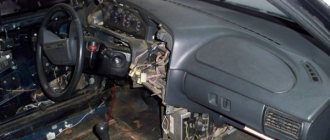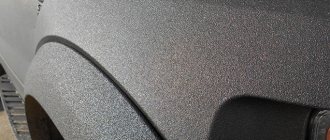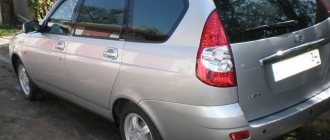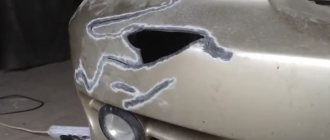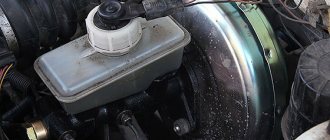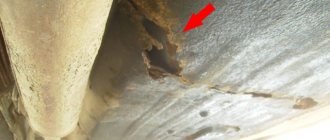What kind of glue should it be?
When choosing automotive glue, you need to focus on several indicators:
- solubility - this indicator affects the ability of the adhesive mixture to dissolve under the influence of chemical solvents. This is important, since high-quality removal of glue will prevent damage to materials;
- drying time is a property that affects the quality of work. With a high crystallization rate, the drying time is reduced, which makes it necessary to use additional heating devices (for example, a heat gun). In addition, this characteristic affects the drying speed;
- thermoplasticity is a characteristic on which the cosmetic part of the repair depends. Glue must also be selected based on the climatic conditions of your region. At very low or high temperatures, some types may not be able to withstand, which will lead to the interior leather peeling off.
The most popular adhesives used for car upholstery are polychloroprene-based and polyurethane-based adhesives. Let's take a closer look at the representatives of each type.
What kind of glue should be used for re-upholstering the ceiling?
Sheathing material plays an important role. It is necessary to glue the ceiling lining with a high-quality compound.
The glue must meet the requirements:
- Connect materials tightly.
- Easily and evenly distributed across materials.
- Don't leave streaks. It is not recommended to glue a black ceiling with white compounds.
- Non-toxic. Toxic fumes accumulate in a confined space and can harm the body.
Moment glue and its analogues are not suitable for ceiling cladding. The compositions turn out to be unstable to temperature changes.
When the air in the cabin heats up, the temperature of the glue will rise, causing toxic fumes into the cabin. The choice should be taken responsibly.
The composition must match the selected material. Popular - leatherette, Alcantara, carpet.
Based on polychloroprene
Polychloroprene-based adhesive is a contact substance applied to the two surfaces being bonded. This glue contains a solvent, which, when evaporated, forms a chemical bond between both sides being glued, resulting in a very strong fixation. In addition, the polychloroprene composition may contain resins and metal oxides, thereby improving the viscosity and thermoplastic properties of the substance.
It should be noted that when gluing, such glue requires thermal activation, which occurs due to the direction of high temperatures (above 60 degrees) to the gluing site. Thanks to these actions, the glue melts, after which both surfaces to be glued are firmly pressed against each other and glued. Within half an hour the product is ready for use.
Among polychloroprene-based adhesives, the most popular are the following:
- “Glue-88” is used for almost any material and is quite resistant to moisture. Reviews about this glue are the most unflattering, not only due to its low fixing properties, but also due to its toxic odor;
- GTA Boterm is a popular Polish glue. Gluing involves thermal activation. This composition shows good thermal and moisture resistance properties;
- Mah is a representative of the German adhesive market, gaining many positive reviews due to its resistance to temperature loads and high quality of fixation. Popular among professionals involved in reupholstering car dealerships.
In addition to the above liquid adhesives, aerosol adhesives are also produced - Tuskbond, Fentac, MultiSpray (the latter performs well in the cold, but melts easily in the heat) and others.
What fabric to choose for car headliner
There are a huge variety of materials that can be used for car ceiling lining. These are car vinyl, carpet, genuine leather, leatherette and many others. Each of them has its own pros and cons, as well as nuances of work when reupholstering.
The best option for reupholstering a car's ceiling trim yourself is automotive velor. This material is durable, inexpensive, and pleasant to the touch. At the same time, you can find many variations of automotive velor on sale, both in color and structure.
The color of the fabric for the car's headliner should be selected based on the overall color of the interior, as well as from the point of view of resistance to dirt. For example, when choosing a bright white color, you should understand that within a few months such fabric will become very dirty. It is better to give preference to materials in soft pastel colors.
Important: In addition to the fact that bright materials quickly get dirty, they can also distract the driver when driving.
If automotive velor is not suitable for some reason, you can also consider the following materials for use as an interior headliner:
Car carpet. A similar material has found application in the automotive industry for covering subwoofers and speakers. It has a good effect on acoustic properties and is perfect for a “musical” car. At the same time, carpet retains its appearance well during long-term use and is available for sale in various color variations. You can also purchase a waterproof car carpet;- Alcantara. Another material that is often used for car ceiling lining. This fabric is a non-woven ultramicrofiber with the characteristics of genuine leather. The material performs well during long-term use - it is easy to clean and resistant to various types of mechanical stress. Due to the fact that Alcantara has high elasticity, it is convenient to use for covering the interior ceiling;
- Leatherette. Genuine leather is rarely used for car interiors due to its high price. But if you need to achieve a respectable look for the interior, you can use leatherette as an alternative to leather. The material can be found in various textures, and it looks great on the ceiling of a car. But it is important to note that leatherette is not particularly durable, and over time, cracks will begin to appear on it. It is also susceptible to scratches.
Please note: When purchasing material for interior trim, it is better to buy it with a significant margin (30-40% more than calculated as a result of measurements). This is due to the fact that in the future, if necessary, it will be quite difficult to find identical material if required.
Choosing a material for re-upholstering the ceiling
When reupholstering the ceiling, you need to take into account that the color of the ceiling should be combined with the color scheme of the car's interior.
It is always difficult to choose just one thing when there is a large number of materials offered by specialized stores. You can limit yourself to the three most popular options: leather, carpet and Alcantara.
The presence of a leather interior will automatically raise the prestige of its owner in the eyes of friends and acquaintances, even if the car brand is not so prestigious. Leather upholstery not only improves the appearance of the interior, but also significantly reduces the noise level. Plus, the likelihood of extraneous noise, creaks, and tapping is reduced, since the joints between the plastic parts of the structure are sealed with leather.
Do-it-yourself ceiling reupholstery with carpet can be done using either glue or thread and a needle. It is very convenient to work with this material. It is elastic, pliable, and looks good. Having a wide selection of carpet in different colors and shades allows you to choose the ideal combination with the color scheme of the car interior.
The most popular material for ceiling upholstery today is Alcantara . It looks beautiful and is very easy to use. For high-end interior reupholstery, Alcantara is often chosen rather than leather. This synthetic material is more expensive than leather, but is more practical when used, because it has the correct shape, is sold in long and wide rolls and covers the entire surface area in one piece.
In appearance it resembles nubuck or heavily worn leather. This artificial material has very high strength and wear resistance. Alcantara is distinguished by a wide range of colors and color fastness both inside and outside the material.
Its undoubted advantage over leather is its strength and thickness. They are identical over the entire surface of the material, which facilitates the manufacture of the interior ceiling panel and its installation in the car.
How to reupholster a car's headliner: instructions
Having chosen the appropriate material and adhesive base, you can proceed directly to work, but it is better to first test the selected consumable components. Take a small piece of fabric and try to fix it with the selected adhesive on a surface close to the one to which the ceiling trim will be glued. You can, for example, reupholster small car inserts, sill parts, handles or other small elements.
Next, proceed directly to the work of reupholstering the ceiling sheathing:
The first step is to remove the ceiling. There is a misconception that this can only be done with the windshield removed, but this is not true. It is enough to dismantle the front passenger seat, after which the ceiling can be reached;- Next, you need to remove the current sheathing and clean the surface of old glue. This can be done using a metallic sponge or sandpaper. Once the old adhesive has been completely removed, run fine-grit sandpaper over the surface to remove any unevenness;
- After this, you can proceed directly to gluing the material. First, apply a thin bead of glue to the center of the surface and glue the central part of the fabric to it. Next, from the center, glue the other sides of the material, 10 centimeters on each side. When you glue, it is important to have an assistant who can pull the material away from the glued center. At the same time, the person who works with glue must constantly ensure that “bubbles” do not form by smoothing the material;
- Having reached the edge of the roof, fold the material onto the back side of the surface and glue it. Cut off the remaining excess pieces of fabric;
- After this, if necessary, make small cuts in the fabric to attach the surface to the car interior, and then install it.
It is recommended to carry out the work described above with gloves. It is better to use cellophane or cotton gloves, but it is important that they are clean, otherwise marks will remain on the new fabric.
Ceiling reupholstery
After removing the struts, it is easy to dismantle the top of the cabin. It is better to remove it through the front right door. The right front side should be at the back at the top, the left side at the front at the bottom. The edges of the ceiling can be slightly bent during removal from the car. The old fabric must be separated and removed. Prepare the frame for gluing the new original upholstery.
Preparation sequence: to make it uniform, coat the ceiling texture with a thin layer of epoxy resin. After hardening, sand with sandpaper. Vacuum, degrease with solvent 646. Then proceed to stick the Alcantara on the outside of the frame. After preliminary preparation, lubricate the surface of the ceiling to be pasted with glue, the outer side of the fabric, cover the frame with the material, and roll with a soft roller. Leave for 24 hours and install in reverse order.
Materials
The choice of material that will be used to cover your car will affect both the appearance of the roof and the technology of work. Among the materials on the market, the following are distinguished:
- Alcantara;
- faux suede;
- almara;
- leatherette, leather, eco-leather;
- ceiling fabric;
- velveteen.
Fortunately, the range of fabrics is so wide that the choice depends only on your tactile and aesthetic preferences, as well as the amount you are willing to spend on repairing or tuning the car interior.
Taste and color...
Of course, each material has its own advantages and disadvantages. Alcantara is a material that has recently become increasingly popular; pleasant to the touch and quite wear-resistant. The main disadvantage is the price. Therefore, artificial suede is often used as a substitute.
Leather or eco-leather will certainly please the eye and will not disappoint the tactile perception. But the price of this material, frankly speaking, bites. As an alternative, you can use leatherette. You can use it to tighten not only the ceiling, but also the door cards. Thus, it is possible to carry out comprehensive tuning of the interior.
The easiest material to work with is ceiling fabric. You can choose not only the color, but also the sewing structure. Like the factory headliner, this fabric often comes with a foam layer.
They may even offer you a material with an adhesive backing (no need to use glue). It is easy to glue, but we do not recommend using such material. Especially if it is from unverified manufacturers, since there have been precedents with peeling of the skin.
Glue
For reupholstering, you can use several options for adhesives:
- GTA Boterm. The glue is really great for working with fabric materials. You can find a lot of positive reviews about this product on the Internet. Polish-made glue and, unfortunately, there is practically no import into the Russian Federation.
- Universal glue "88". The most popular composition, which, we must admit, not all car owners like. They especially emit a persistent toxic odor.
- Glue Moment-1. A universal waterproof composition that offers excellent price-quality ratio.
- Kaiflex K414 glue. A fairly good composition that can also be used to glue any material.
Before you start gluing, carefully read the instructions and tips for use. Due to high temperatures in summer and low winters, as well as exposure to moisture and other negative factors, reupholstery technology must be strictly observed. Only in this case will you be sure that the covering will not come off after a few months.
Do-it-yourself sheathing replacement
Reupholstering a car ceiling with your own hands requires complete dismantling of the car's interior roof. Often the frame resembles a mixture of fiberglass, epoxy glue and wood chips. It is quite strong and elastic, but numerous folds or lack of support, causing sagging under its own weight, can lead to rupture or the appearance of noticeable folds. Repairs can be made using fiberglass and epoxy glue. The video shows the repair process.
For example, on sedans the ceiling is often pulled out through one of the doors, crushing it as carefully as possible. In order to remove the ceiling, you will need to unscrew all the visors and remove the plastic elements.
Plywood
- Remove old material.
- Using a brush or coarse sandpaper, remove any remaining foam rubber and glue.
- Go over the entire surface with a rag soaked in degreaser.
- Cover the entire surface of the ceiling base with glue, leaving it for 15-20 minutes. for drying;
- You need to glue the fabric from one edge, gradually moving to the opposite corner. Some craftsmen advise covering a thin area in the middle with glue, and then gradually moving towards the edges. Which method to use is up to you. In any case, you should not apply too much glue so that it does not have time to dry. A strip 10 cm from the place that you have already glued will be enough. And also be careful with the layer of adhesive. A layer that is too thick may soak through the fabric and leave a stain on the material. To ensure that the surface remains clean after smoothing the material, you need to wear gloves when gluing the ceiling fabric (keep them clean at all times).
- After the repair has been completed, leave the ceiling for 24 hours;
- Cut openings for fastening handles, visors, lampshades, etc.
Now the interior tuning is almost complete. All that remains is to assemble the interior and evaluate the overall harmony of the interior of the car. If you still have, for example, leatherette, you can use it to cover some plastic elements. You will see that tuning a car interior is quite an entertaining and uncomplicated activity.
Description of material
Alcantara is a material obtained through the use of modern high technologies. This is an artificial fabric somewhat reminiscent of suede, having a thread base of thin fiber. The upholstery is created specifically for use in the car interior. Compared to leather, it is softer, more elastic, and aesthetically attractive.
The main advantages of Alcantara:
- resistance to high temperatures;
- the highest resistance to mechanical damage, it is practically impossible to cut;
- durability.
Conventional fabric materials used for car upholstery, seats, and ceilings absorb various foreign odors. With Alcantara and leather, the car owner immediately forgets about this problem. It is hygroscopic and does not react to odors at all. Moreover, she doesn’t even care about serious temperature fluctuations. Warm, soft, pleasant to the touch, like natural suede, despite the fact that the material is an artificially created fabric.
The anti-glare effect gives Alcantara a natural, sophisticated look. Its elastic structure allows for much more creativity when modeling a car interior compared to leather. The material has an unlimited number of color shades. Leather cannot be dyed this way. Strength based on high technology allows you to perform on the Alcantara surface:
- embroidery;
- inlay;
- perforation;
- embossing
Creating a car design from Alcantara is beneficial for car owners and craftsmen. The salon then serves for several decades. The workshop has waste-free production. Compared to leather, there is no need to eliminate defects or cut out blemishes, since they simply do not exist. The material is excellent, warm in winter, cool in summer. She breathes in a car, similar to skin.
Ceiling in a car, reupholstering the ceiling of a car with your own hands
Over time, the ceiling upholstery in the car gets dirty, deteriorates and fades. This is especially true for ceilings that are made of light materials. As a result of normal wear and tear, they darken and resemble dirty gray rags. At the same time, in the places where the sun visors are located, the original appearance of the upholstery is preserved. That is why, every time these visors are lowered, any car owner begins to think about reupholstering the ceiling of the car. However, not all car enthusiasts immediately decide to take this step. First, they try to use other means to restore the ceiling, for example, dry cleaning. However, as a rule, if the product is old, these measures are not able to help it. Some car enthusiasts buy “dry dry cleaning”, which can completely ruin the upholstery. After finishing the ceiling with this product, the fabric may separate from the foam, which will further aggravate the situation. Therefore, reupholstering the ceiling is the best way out of this situation. More on this later in the article.
Car ceiling reupholstery price
The cost of ceiling lining in a car from professionals depends on the make of the car and average prices in Russian cities. The category of the car service, its equipment and the qualifications of the workers are of great importance. Additional services for straightening the roof, installing lamps and sound insulation add to the cost of the work. If the owner wants to see airbrushing or other tuning on the ceiling, he should turn to professionals. You need to study the market for offering this service in advance. You can order the ceiling trim in the studio. The average price for cladding is 10,000 rubles.
Re-upholstering the ceiling yourself is difficult, but doable. You need organization, accuracy, and attentiveness. If a person has the listed qualities, you can safely take on the task of doing your own cladding.
The safety of the interior is the first thing a potential car buyer pays attention to. Drivers who consider the option of possibly selling their car in the future pay close attention to their interior so as not to damage the trim. But even with the most careful use of the car, over time, the roof lining in the cabin will deteriorate - it will fade or get dirty, especially if it is made of light-colored materials.
If the car's headliner has deteriorated, the surest option to return it to its “marketable” appearance is to reupholster it. Such work at service stations costs a lot, but you can do it yourself if you choose the right material and take into account all possible nuances. In this article, let's look at how to reupholster a car's ceiling trim with your own hands.
Re-upholstering the ceiling, how to stick the material onto the matrix, step-by-step progress of work
At its core, ceiling reupholstery is simply gluing material onto a matrix. It's almost the same as wallpapering. But your main task is to glue the fabric evenly, without wrinkles. Therefore, it is advisable to carry out this event together with an assistant.
Apply a thin strip of glue approximately ten centimeters long in the center of the matrix. Next, you need to attach the main part of the fabric trim to the strip. Using the same method, we glue each side of the fabric in turn from the center of the matrix. Glue needs to be lubricated every ten centimeters of the surface.
The assistant’s main task is to pull the material to the sides from the glued center. At the same time, you should smooth the fabric. These steps should be performed while wearing cotton or cellophane gloves. If you prefer cotton mittens, you need them to be white. Otherwise, stains will remain on the light fabric, so you need to act as carefully as possible.
When gluing ten centimeters on each side, you need to monitor the bends of the matrix. Glue the fabric to the ceiling surface as tightly as possible. Next, wrap and glue the edges of the material. Excess pieces of fabric must be carefully trimmed. Then make certain holes for the fasteners, and then install the ceiling back into the cabin.
How to change the headliner in a car yourself
Over time, the ceiling upholstery in a car gets dirty, fades and deteriorates. This is especially true for ceilings made of light-colored materials. With “old age” they darken and look more like dirty gray rags. At the same time, in the places where the sun visors are located, the upholstery remains new. Therefore, every time they are lowered, any driver has the thought of re-upholstering the ceiling of the car.
But not all motorists immediately decide to take such a step. They first try other means to renew the ceiling, such as dry cleaning. As a result, they throw money away, because if the product is old, nothing will help it. Some drivers buy so-called dry cleaning, which can completely ruin the upholstery. After treating the ceiling with this product, the fabric peels off from the foam rubber.
Therefore, the best way out of this situation would be to reupholster the ceiling in the car. We will tell you how easy it is to perform this procedure yourself, without the help of specialists. First of all, you need to choose the right upholstery material.
What upholstery material to choose
Some drivers cover the ceilings with leather or leatherette, auto vinyl, or carpet. But we recommend that you use auto velor. This material looks very beautiful and is pleasant to the touch. The modern market offers us a wide variety of automotive velor. Choose stretch velor with a large cell structure. It looks like 3D carbon film and is very practical to use. Such car velor practically does not get dirty, and minor dirt can be easily removed.
As for the color of the future ceiling, we recommend choosing calm pastel shades. You should not give preference to bright white color - it is too easily soiled and will very soon turn into a dirty gray rag. It will be easier for you to work with materials in discreet tones, since flaws are not visible on them. In addition, bright colors distract the driver from the road, irritate and tire the eyesight. When choosing a shade of material for the ceiling, remember - it must be combined with the colors of other interior elements.
Do-it-yourself ceiling cladding
Having decided on the material for reupholstering the car ceiling, proceed to the procedure itself. The first and most difficult thing you need to do is remove the ceiling. Many drivers mistakenly believe that this requires removing the windshield. However, this is not so: it is enough to remove the front passenger seat and reach the ceiling through the rear door of the car.
The video shows the removal and reupholstery of the ceiling on a Passat B3:
It is necessary to remove the old coating and glue residues from the ceiling. To do this, use a solvent and a hard sponge. Then we recommend going over the surface with sandpaper. This will eliminate all irregularities. In addition, the new coating will adhere better to rough surfaces. Glue the auto velor onto the ceiling matrix using “88” glue. It perfectly bonds non-porous materials.
In essence, do-it-yourself reupholstery comes down to simply gluing the material onto the matrix. It's no more difficult than wallpapering. However, your main task is to glue the fabric evenly, without a single fold. Therefore, it is better to perform this procedure together with an assistant.
To begin, apply a thin strip of glue in the center of the matrix. Its length should be about ten centimeters. Then attach the central part of the fabric scrap to the strip. Using the same method, glue each side of the fabric in turn from the center of the matrix (apply glue every ten centimeters of the ceiling).
The task of your assistant is to pull the auto velor on the sides of the glued center. At this time, you yourself must smooth the material from the center to its edges. Carry out these steps while wearing cellophane or cotton gloves. If you choose cotton mittens, they should be white. Otherwise, stains may remain on light-colored fabric, so proceed as carefully as possible.
When gluing ten centimeters on each side, watch the bends of the matrix. You must glue the material as tightly as possible to the surface of the ceiling. Wrap and glue the edges of the car velor. Carefully trim off excess pieces of fabric. Then carefully make small holes for the fasteners and then proceed to install the ceiling matrix into the interior.
Useful tips
When carrying out the ceiling covering procedure, follow some rules. First of all, we advise you to take care of a sufficient amount of fabric in advance. Also prepare auxiliary tools. The beauty of a material such as automotive velor is that it does not require the use of any special devices. All you need to do is prepare the fabric itself, good glue, a leather roller and a hair dryer.
Which glue to choose
Some drivers don’t bother too much about glue and fix the material using “Moment”. However, this should not be done, since such a product emits toxic fumes when exposed to sunlight. Therefore, the best option would be “88” glue. You can also buy spray adhesive. Its advantages are good surface distribution and quick drying. However, in order to use this tool correctly, you must carefully study the instructions.
Video about reupholstering a car ceiling:
Start small
If you have not previously reupholstered the interior or dealt with car velor, we recommend that you practice in advance. Try covering some small element with fabric first. For example, drag handles, door sill parts or inserts on car doors. Once you are sure that everything is working out well for you, proceed to reupholstering more complex interior elements.
Alternative materials for upholstery
Of course, you don’t have to reupholster the ceiling in your car with velor. There are other materials that have their own advantages. Let's take a closer look at the advantages of other fabrics for upholstery.
Alcantara
Today, Alcantara upholstery of the interior and, in particular, the ceiling of a car is becoming increasingly popular. This is due to the excellent characteristics of this material. Alcantara is ideal for conditions of intensive use of the car interior. It is a non-woven ultramicrofiber that has all the qualities inherent in natural leather. Moreover, the cost of such material is much lower.
Alcantara is highly elastic, making it well suited for ceiling coverings. When working with it, practically no folds are formed. In addition, this material is repairable and durable, and therefore durable. The Alcantara ceiling is easy to clean and resistant to various mechanical influences. This is especially true for those motorists who often have children in the car.
Autocarpet
Automotive carpet is mainly used for tuning or covering subwoofers, as it can improve acoustic properties. However, it is also excellent for covering the ceiling, since it stretches well and takes the shape of any element of the interior. There are several types of carpet, including waterproof materials. The color range of autocarpet is very diverse.
Leatherette
Leather substitute is quite often used to cover the ceiling of a car. The material looks very beautiful and respectable. However, leatherette has a couple of disadvantages. Firstly, when pasting the ceiling of a car, it can wrinkle, and secondly, it is not very durable and will form cracks over time.
In the video, the ceiling is reupholstered on an Opel Vectra:
Now you know how to reupholster a car ceiling without going to a workshop. If you do everything in accordance with our instructions, then the ceiling will please your eyes for a long time. The main thing is to do everything carefully and slowly. And remember - the upholstery material must be elastic. Only in this case the ceiling will be smooth, without wrinkles.
Please leave your comment on the article! We are interested in your opinion.
365cars.ru
Pro tips on what kind of glue you need, how to work with car velor
In the process of covering the ceiling, certain rules must be followed. Make sure you have enough material. Prepare auxiliary tools in advance. The advantage of automotive velor is that it does not require the use of any special devices.
Some car owners don’t bother too much when choosing glue and fix the fabric using “Moment”. But this is prohibited, since this product, under the influence of sunlight, can release toxic fumes. The best option in this case is “88” glue. You can also use spray adhesive. Its advantages are fast drying and excellent surface distribution. But, before using this product, carefully read the instructions.
If you have not previously dealt with auto velor and have not reupholstered the ceiling, we recommend that you practice beforehand. First, try covering a small element with the material. For example, drag handles, threshold parts, and so on.


